by C. Elkins, OK Math and Reading Lady
Last week I posted my thoughts about multiplication strategies using the repeated addition strategy. This time I will focus on using arrays. Do you have some arrays in your classroom? Look for them with bookshelves, cubbies, windows, rows of desks, floor or ceiling tiles, bricks, pocket charts, etc. Students need to know arrays are everywhere! It is also very helpful for students to build arrays with objects as well as draw them. This assists students with moving from concrete to pictorial representations — then the abstract (numbers only) can be conceptualized and visualized more easily. Some good materials for arrays:
- cubes
- tiles
- circular disks
- flat stones
- pinto beans (dry)
- grid or graph paper
- bingo stamper (to stamp arrays inside grids)
- mini stickers
- candy (Skittles, M&Ms, jellybeans)
Array Basics:
- Arrays form rectangular shapes.

- Arrays are arranged in horizontal rows and vertical columns. This vocabulary is very important!
- The number of objects in each row (and column) in an array are equal.
- Arrays can be formed by objects, pictures, or numbers.
- Arrays can be described using numbers: If there are 4 rows and 3 columns, it is a 4 by 3 array.
- The number of rows and number in each row are the factors. The product is the total.
- When an array is rotated, this shows the commutative property.
- 4 x 6
- 6 x 4
Ways to incorporate arrays into story problems:
- Desks in a class (5 rows, 4 desks in each row)
- Chairs in a classroom or auditorium (10 rows of chairs, 8 chairs in each row)
- Plants in a garden (6 rows of corn, 8 corn plants in each row)
- Boxes in a warehouse (7 stacks, 5 boxes in each stack)
- Pancakes (3 stacks, 5 pancakes in each stack)
- Cars in a parking lot (4 rows, 5 cars in each row)
- Bottles of water in a crate (3 rows, 8 bottles in each row)
- Donuts or cupcakes in a box (how many rows? how many in each row)
Activities to encourage concrete and pictorial construction of arrays:
- Start off using manilla grid paper you probably have available with the construction paper supply at your school. This will help students keep their rows and columns even. Pose a problem and allow students to use manipulatives you have available to construct the array. If you say, “Build an array for this multiplication problem: 3 x 5,” do they know the 3 refers to # of rows and the 5 refers to the number in each row?
- Turn the paper after building the above array to see the commutative property. Now the picture shows 5 x 3 (5 rows with 3 in each row). The product is still 15.
- Use the manilla grid paper along with bingo dobbers to create the array. The grids can also be completed with mini stickers (I get them all the time in junk mail) or drawings.
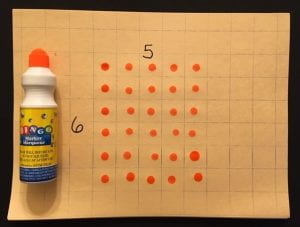
- When using pictures of arrays, direct your students to always label 2 sides of the array (the rows and columns). Try to label different sides of the array so it’s not always presented in the same format.
- Find the product: The whole point of using an array as a multiplication strategy is to visualize the rows and columns to help calculate the product. If students create rows and columns and then just count the objects one-by-one, then this does not accomplish the objective. Show students how to skip count using the # of objects in the rows or columns. Believe me, students don’t always know to do this without a hint from the teacher. Or better yet, before actually telling them to do this, ask students this question: “How did you get the total number of objects?” When you pose this question, you are honoring their strategy while secretly performing an informal assessment. Then when the student who skip counted to find the total shares their strategy, you give them the credit: “That is an efficient and fast way to count the objects, thank you for sharing! I’d be interested to see if more of you would try that with the next problem.” Plus now students have 2 strategies.

- Use the distributive property to find the product: Let’s suppose the array was 6 x 7. Maybe your students are trying to count by 6’s or 7’s to be more efficient – but the problem is that counting by 6’s or 7’s is difficult for most students. Break up (decompose) the array into smaller sections in which the student can use their multiplication skills. Decomposing into rows or columns of 2’s and 5’s would be a good place to start. This is the distributive property in action – and now the students have 3 strategies for using an array!! This is a great way to use known facts to help with those being learned.
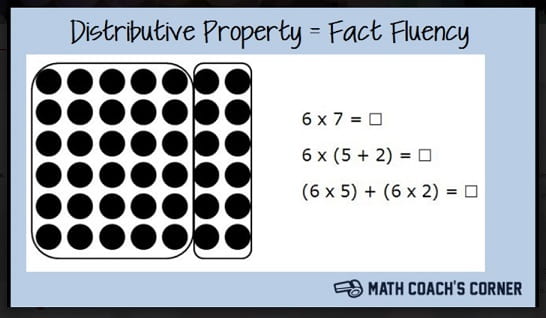 Here is a link to Math Coach’s Corner (image credited above) and a great array resource: Multiplication arrays activities from TPT $5.50. Here is my FREE guided teaching activity to help students decompose an array into 2 smaller rectangles. Click HERE for the free blank template.
Here is a link to Math Coach’s Corner (image credited above) and a great array resource: Multiplication arrays activities from TPT $5.50. Here is my FREE guided teaching activity to help students decompose an array into 2 smaller rectangles. Click HERE for the free blank template.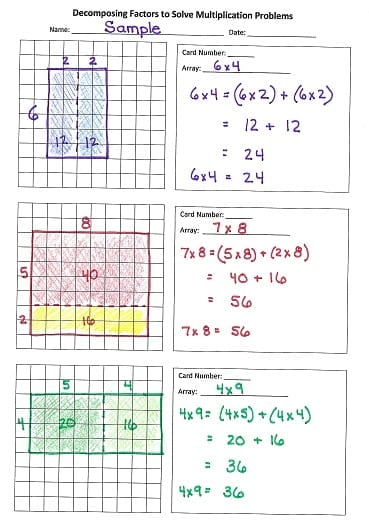
- Use the online geoboard I described a few posts back to create arrays using geobands. Click here for the link: Online geoboard Click here for the previous post: Geometry websites (blog post)
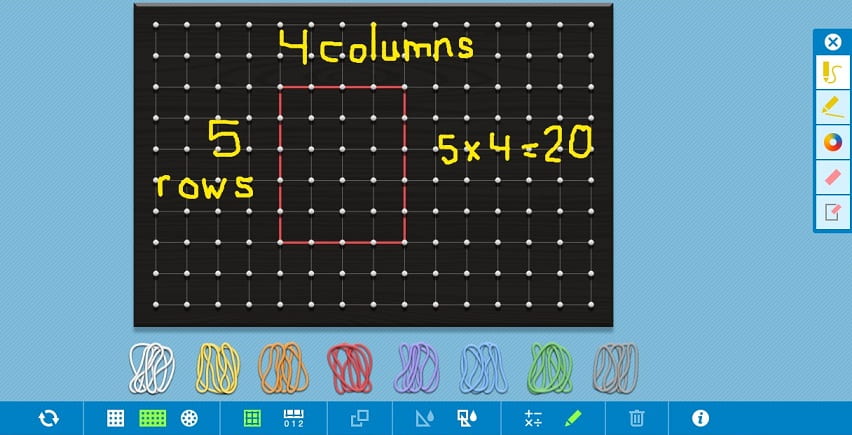
- Try these freebies: Free array activities from k-5mathteachingresources.com. Here’s a sample.
- Play this game I call “Block-It.” This is a competitive partner game in which students must create arrays on grid paper. Click here for a FREE copy of the directions: Block-It Game Directions
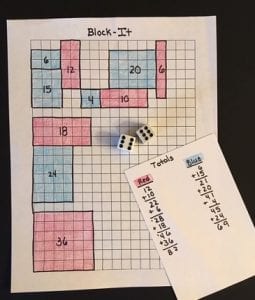
- Relate use of arrays when learning strategies for division and area.
In a future post I will show some ways to use manipulatives and pictures arrays for double digit multiplication problems. Stay tuned!!
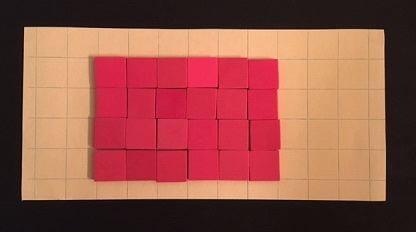


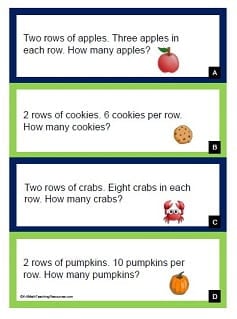
Thank you for sharing these activities/ideas! I definitely prefer these to my strategy of using skittles to teach arrays! I think the school custodians will probably like these strategies better too!
Thank you! I’ll admit I’ve used candy too. Great for graphing and probability too! I hope to cross paths with you in your new position. Good luck!